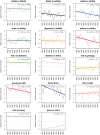Historical representations of social groups across 200 years of word embeddings from Google Books
- PMID: 35787033
- PMCID: PMC9282454
- DOI: 10.1073/pnas.2121798119
Historical representations of social groups across 200 years of word embeddings from Google Books
Abstract
Using word embeddings from 850 billion words in English-language Google Books, we provide an extensive analysis of historical change and stability in social group representations (stereotypes) across a long timeframe (from 1800 to 1999), for a large number of social group targets (Black, White, Asian, Irish, Hispanic, Native American, Man, Woman, Old, Young, Fat, Thin, Rich, Poor), and their emergent, bottom-up associations with 14,000 words and a subset of 600 traits. The results provide a nuanced picture of change and persistence in stereotypes across 200 y. Change was observed in the top-associated words and traits: Whether analyzing the top 10 or 50 associates, at least 50% of top associates changed across successive decades. Despite this changing content of top-associated words, the average valence (positivity/negativity) of these top stereotypes was generally persistent. Ultimately, through advances in the availability of historical word embeddings, this study offers a comprehensive characterization of both change and persistence in social group representations as revealed through books of the English-speaking world from 1800 to 1999.
Keywords: attitude change; natural language processing; stereotype change; word embeddings.
Conflict of interest statement
The authors declare no competing interest.
Figures



References
-
- Charlesworth T. E. S., Banaji M. R., “Word embeddings reveal social group attitudes and stereotypes in large language corpora” in Handbook of Language Analysis in Psychology, Dehghani M., Boyd R. L., Eds. (Guilford Press, 2022; ), pp. 494–508.
-
- Katz D., Braly K., Racial stereotypes of one hundred college students. J. Abnorm. Soc. Psychol. 28, 280–290 (1933).
-
- Gilbert G. M., Stereotype persistence and change among college students. J. Abnorm. Psychol. 46, 245–254 (1951). - PubMed
-
- Karlins M., Coffman T. L., Walters G., On the fading of social stereotypes: Studies in three generations of college students. J. Pers. Soc. Psychol. 13, 1–16 (1969). - PubMed
Publication types
MeSH terms
LinkOut - more resources
Full Text Sources

